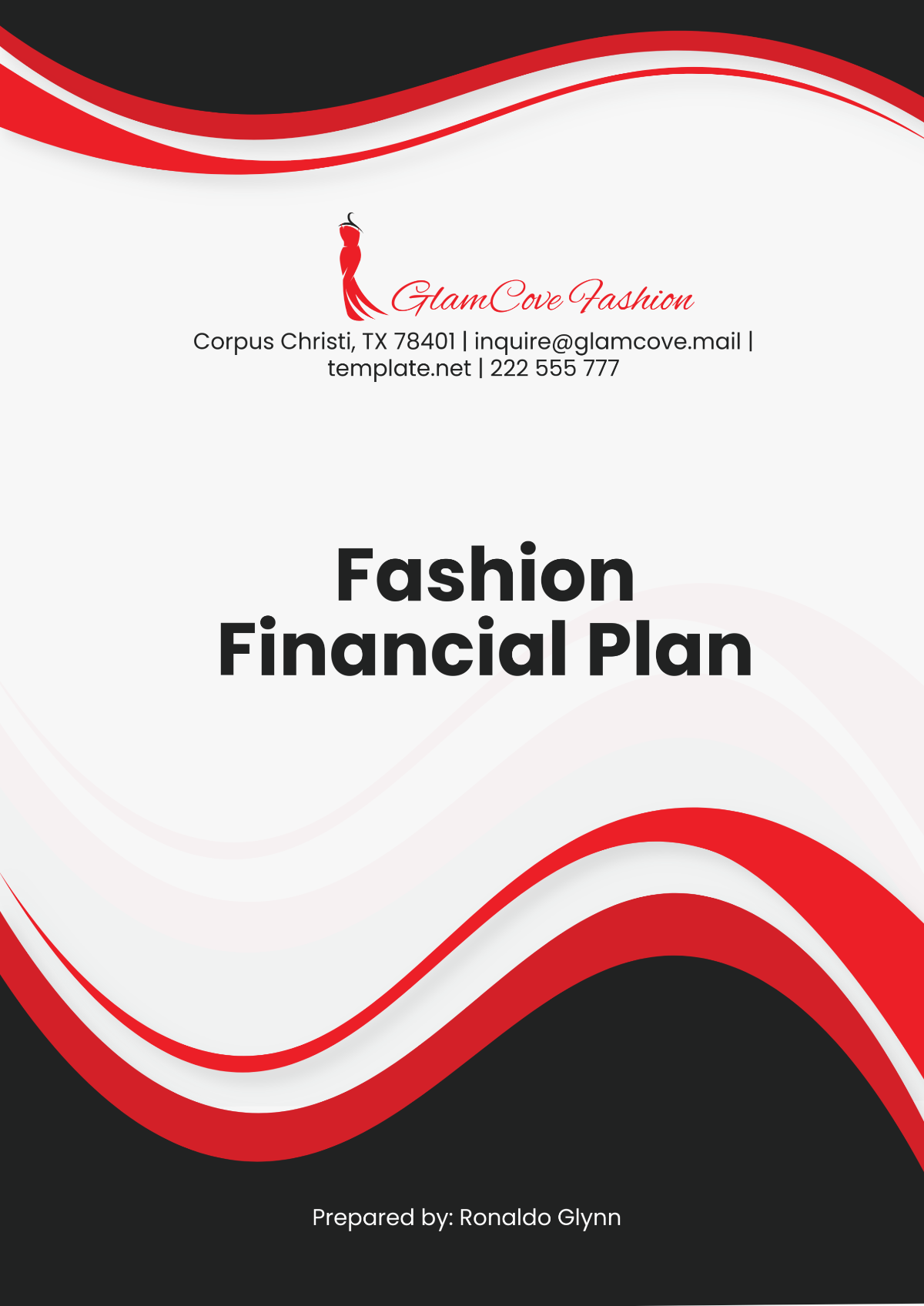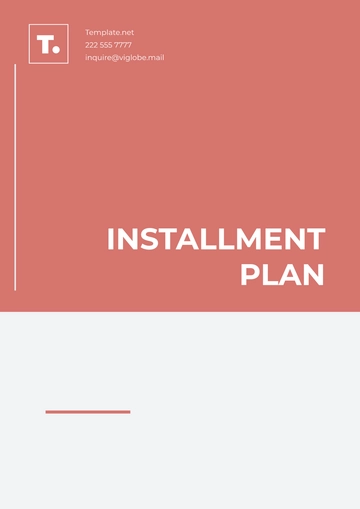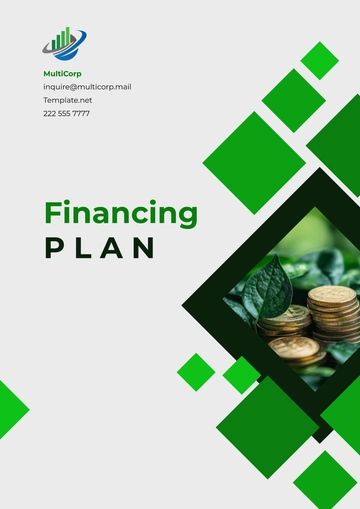Free Fashion Financial Plan

I. Executive Summary
This financial plan outlines the key goals and strategies for [Your Company Name] as it aims to strengthen its position in the competitive fashion industry. With an emphasis on expanding market share, increasing revenue, and enhancing brand recognition, [Your Company Name] is poised to capitalize on emerging trends, target new customer segments, and leverage innovative marketing strategies. The company seeks to build on its existing foundation by enhancing product offerings, optimizing operational efficiency, and driving engagement through digital platforms. By focusing on these strategic areas, [Your Company Name] will be well-positioned to maintain long-term growth and profitability.
The financial strategy includes a clear roadmap for sustainable growth, with investment in key areas such as product development, customer acquisition, and strategic partnerships. In addition, the plan focuses on diversifying revenue streams, implementing cost-effective operations, and managing risks associated with market fluctuations. By prioritizing financial discipline and aligning expenditures with growth initiatives, [Your Company Name] aims to create a strong financial foundation that will support future expansion efforts. Through a combination of strategic planning, careful financial management, and brand-building initiatives, [Your Company Name] is committed to achieving its objectives and establishing itself as a leader in the fashion industry.
II. Company Description
[Your Company Name] is a dynamic and innovative fashion company dedicated to providing high-quality apparel and accessories that meet the diverse needs of modern consumers. Founded in 2050, the company has quickly established itself as a trendsetter in the industry, combining cutting-edge designs with sustainable practices. With a focus on versatility, style, and comfort, [Your Company Name] offers a wide range of products that cater to both men and women, with collections that span from everyday wear to special occasion attire. The company prides itself on creating clothing that empowers individuals and enhances their confidence, all while promoting ethical manufacturing processes.
Headquartered in [City, State], [Your Company Name] operates both online and through a network of brick-and-mortar stores across key regions. The company’s e-commerce platform has experienced significant growth, driving an increasing portion of its revenue. With a growing customer base, [Your Company Name] has adopted a direct-to-consumer model that allows for greater control over product offerings, pricing, and customer relationships. This strategy has not only improved customer satisfaction but has also resulted in higher margins and more streamlined operations.
Looking toward the future, [Your Company Name] is committed to continuous growth and innovation. The company aims to expand its market presence, introduce new collections, and enhance its global reach. By investing in both product development and brand-building initiatives, [Your Company Name] intends to strengthen its position in the competitive fashion market while staying true to its core values of quality, sustainability, and customer-centricity. With a solid foundation and a forward-thinking approach, [Your Company Name] is prepared to lead the way in shaping the future of fashion.
III. Industry Analysis
A. Market Overview
The global fashion industry is experiencing substantial growth, with a projected market value reaching trillions of dollars in the next decade. Key drivers include increased digitalization, which has transformed how consumers shop, shifting from traditional retail to online platforms. E-commerce has become a significant revenue generator, allowing brands to reach a global audience. Moreover, consumer preferences are evolving, with an increasing demand for personalized, casual, and functional fashion that suits modern lifestyles.
Sustainability is another major trend driving growth in the industry. Consumers are increasingly prioritizing ethical and eco-friendly fashion choices, leading brands to invest in sustainable sourcing, production methods, and materials. The shift toward environmentally conscious fashion is not only reshaping product offerings but also influencing consumer purchasing decisions. As a result, the fashion industry is becoming more innovative, as brands adapt to these changes to stay relevant in a competitive global market.
B. Competitive Analysis
The competitive landscape consists of both large, established players and up-and-coming designers, but [Your Company Name] stands out through its commitment to sustainability and a digital-first approach. This allows the company to effectively differentiate itself, offering an attractive alternative to both traditional and emerging brands in the market.
Competitor Type | Challenges | Our Advantage |
|---|---|---|
Established Brands | Large marketing budgets, established market presence | Focus on sustainability and ethical practices, more personalized customer experience |
Emerging Designers | Limited brand recognition and resources | Strong e-commerce presence, efficient direct-to-consumer model |
Sustainability-Focused Brands | Need for more innovation and scalability | Deep commitment to sustainability and eco-friendly practices integrated into all operations |
IV. Marketing Strategy
Our marketing strategy will leverage targeted digital campaigns, influencer collaborations, and exclusive pop-up events to boost brand visibility, engage customers, and drive sales. By focusing on key markets and utilizing innovative promotional tactics, we aim to establish a strong presence in the fashion industry, fostering brand loyalty and attracting new customers.
1. Digital Campaigns
Targeted Advertising: Utilize social media platforms (Instagram, TikTok, Facebook) to create highly targeted ad campaigns based on consumer demographics and behavior. These ads will highlight new collections, exclusive offers, and brand values.
SEO and Content Marketing: Invest in search engine optimization (SEO) to increase organic traffic to our website. Regular blog posts, style guides, and trend articles will engage customers and position [Your Company Name] as a thought leader in fashion.
Email Marketing: Implement segmented email campaigns to deliver personalized messages, product recommendations, and promotions to existing customers and new leads, increasing customer retention and conversion rates.
2. Influencer Partnerships
Collaborations with Fashion Influencers: Partner with micro and macro-influencers whose followers align with our target demographic. Influencers will showcase our products through styling tutorials, unboxing, and sponsored posts.
Affiliate Marketing: Launch an affiliate program, allowing influencers and fashion bloggers to earn commissions by promoting our products and driving traffic to our e-commerce site.
Celebrity Endorsements: If feasible, work with high-profile personalities to enhance brand credibility and reach a broader audience, generating buzz around limited edition or exclusive collections.
3. Pop-Up Events
Strategic Locations: Host pop-up events in key fashion-forward cities to generate excitement around product launches. Locations will include trendy urban areas, fashion festivals, and exclusive retail spaces.
Experiential Marketing: Create immersive brand experiences, such as custom fitting sessions, live music, or collaboration displays with local artists, to create lasting memories and foster a deeper connection with customers.
Local Partnerships: Collaborate with local businesses, artists, or influencers to amplify the event's impact and draw in more attendees.
4. Social Media Engagement
User-Generated Content: Encourage customers to share their purchases and outfits on social media by using branded hashtags, offering contests, or incentivizing them with discounts. This will help create an active, engaged community around the brand.
Instagram and TikTok Reels: Invest in short-form video content showcasing behind-the-scenes looks, fashion tips, and customer testimonials to leverage the growing popularity of visual, quick-bite content.
Live Streaming: Host live streaming sessions where we showcase new collections, provide styling tips, and interact directly with the audience, allowing for immediate feedback and interaction.
5. Strategic Collaborations and Sponsorships
Fashion Week Sponsorships: Sponsor fashion events and shows to increase visibility and position the brand as a key player in the fashion industry.
Collaborative Collections: Partner with complementary brands or celebrities for limited-edition collections that build hype and attract a diverse customer base.
Charity Events: Sponsor or participate in charity-driven fashion events to align the brand with social causes, reinforcing our sustainability and ethical values.
V. Financial Projections
A. Revenue Forecast
We project a steady increase in revenue over the next five years, driven by expanded product lines and market penetration strategies.
B. Expense Budget
Major expenses include production costs, marketing expenses, and operational expenditures.
Category | Amount ($M) |
|---|---|
Production Costs | 0.8 |
Marketing | 0.5 |
Operations | 0.4 |
VI. Cash Flow Analysis
[Your Company Name] projects a steady and positive cash flow driven by strategic revenue growth initiatives and disciplined expense management. By leveraging planned marketing efforts, optimized production costs, and an efficient e-commerce platform, we aim to maintain a healthy balance between inflows and outflows, ensuring financial stability. Anticipated revenue growth will be fueled by increased sales from expanded product offerings, market penetration into key demographics, and enhanced customer acquisition strategies.
To safeguard liquidity, we are implementing strict cost control measures, including streamlined supply chain management and careful monitoring of operating expenses. Our focus on sustainability also provides cost-saving opportunities, such as reduced material waste and partnerships with eco-conscious suppliers. Additionally, the reinvestment of profits into high-growth areas like digital marketing and product innovation will support long-term financial health. With these measures in place, [Your Company Name] is well-positioned to sustain a positive financial position and meet both short-term operational needs and long-term strategic objectives.
VII. Risk Assessment
[Your Company Name] recognizes several potential risks that could impact its operations and financial performance. By identifying these risks early and implementing mitigation strategies, the company aims to safeguard its growth and stability.
Risk | Description | Mitigation Strategy |
|---|---|---|
Supply Chain Disruptions | Delays or disruptions in the supply chain due to global events, natural disasters, or supplier issues. | Diversify suppliers across regions, maintain buffer inventory, and build long-term relationships with reliable suppliers. |
Shifts in Consumer Trends | Rapid changes in fashion trends or consumer preferences that may lead to decreased product demand. | Use trend forecasting tools, conduct regular market research, and adopt flexible product development processes. |
Economic Fluctuations | Economic downturns, inflation, or currency fluctuations that affect consumer spending and operating costs. | Offer a mix of premium and budget-friendly product lines, hedge currency risks, and maintain a reserve fund. |
Competitive Pressure | Increased competition from established brands or new entrants impacting market share and profitability. | Differentiate through sustainability, innovative marketing, superior customer service, and loyalty programs. |
This financial plan positions [Your Company Name] for sustainable growth and long-term success in the competitive fashion industry. By leveraging innovative marketing strategies, efficient operations, and a commitment to sustainability, [Your Company Name] is prepared to achieve its objectives, adapt to market changes, and deliver exceptional value to stakeholders.
- 100% Customizable, free editor
- Access 1 Million+ Templates, photo’s & graphics
- Download or share as a template
- Click and replace photos, graphics, text, backgrounds
- Resize, crop, AI write & more
- Access advanced editor
Manage your budget effectively with the Fashion Financial Plan Template from Template.net. Fully editable and customizable, this template helps you outline expenses, revenue projections, and financial goals tailored to your fashion business. Easily editable in our Ai Editor Tool, ensuring a professional and organized approach to financial planning. Strengthen your business strategy with this essential template.
You may also like
- Finance Plan
- Construction Plan
- Sales Plan
- Development Plan
- Career Plan
- Budget Plan
- HR Plan
- Education Plan
- Transition Plan
- Work Plan
- Training Plan
- Communication Plan
- Operation Plan
- Health And Safety Plan
- Strategy Plan
- Professional Development Plan
- Advertising Plan
- Risk Management Plan
- Restaurant Plan
- School Plan
- Nursing Home Patient Care Plan
- Nursing Care Plan
- Plan Event
- Startup Plan
- Social Media Plan
- Staffing Plan
- Annual Plan
- Content Plan
- Payment Plan
- Implementation Plan
- Hotel Plan
- Workout Plan
- Accounting Plan
- Campaign Plan
- Essay Plan
- 30 60 90 Day Plan
- Research Plan
- Recruitment Plan
- 90 Day Plan
- Quarterly Plan
- Emergency Plan
- 5 Year Plan
- Gym Plan
- Personal Plan
- IT and Software Plan
- Treatment Plan
- Real Estate Plan
- Law Firm Plan
- Healthcare Plan
- Improvement Plan
- Media Plan
- 5 Year Business Plan
- Learning Plan
- Marketing Campaign Plan
- Travel Agency Plan
- Cleaning Services Plan
- Interior Design Plan
- Performance Plan
- PR Plan
- Birth Plan
- Life Plan
- SEO Plan
- Disaster Recovery Plan
- Continuity Plan
- Launch Plan
- Legal Plan
- Behavior Plan
- Performance Improvement Plan
- Salon Plan
- Security Plan
- Security Management Plan
- Employee Development Plan
- Quality Plan
- Service Improvement Plan
- Growth Plan
- Incident Response Plan
- Basketball Plan
- Emergency Action Plan
- Product Launch Plan
- Spa Plan
- Employee Training Plan
- Data Analysis Plan
- Employee Action Plan
- Territory Plan
- Audit Plan
- Classroom Plan
- Activity Plan
- Parenting Plan
- Care Plan
- Project Execution Plan
- Exercise Plan
- Internship Plan
- Software Development Plan
- Continuous Improvement Plan
- Leave Plan
- 90 Day Sales Plan
- Advertising Agency Plan
- Employee Transition Plan
- Smart Action Plan
- Workplace Safety Plan
- Behavior Change Plan
- Contingency Plan
- Continuity of Operations Plan
- Health Plan
- Quality Control Plan
- Self Plan
- Sports Development Plan
- Change Management Plan
- Ecommerce Plan
- Personal Financial Plan
- Process Improvement Plan
- 30-60-90 Day Sales Plan
- Crisis Management Plan
- Engagement Plan
- Execution Plan
- Pandemic Plan
- Quality Assurance Plan
- Service Continuity Plan
- Agile Project Plan
- Fundraising Plan
- Job Transition Plan
- Asset Maintenance Plan
- Maintenance Plan
- Software Test Plan
- Staff Training and Development Plan
- 3 Year Plan
- Brand Activation Plan
- Release Plan
- Resource Plan
- Risk Mitigation Plan
- Teacher Plan
- 30 60 90 Day Plan for New Manager
- Food Safety Plan
- Food Truck Plan
- Hiring Plan
- Quality Management Plan
- Wellness Plan
- Behavior Intervention Plan
- Bonus Plan
- Investment Plan
- Maternity Leave Plan
- Pandemic Response Plan
- Succession Planning
- Coaching Plan
- Configuration Management Plan
- Remote Work Plan
- Self Care Plan
- Teaching Plan
- 100-Day Plan
- HACCP Plan
- Student Plan
- Sustainability Plan
- 30 60 90 Day Plan for Interview
- Access Plan
- Site Specific Safety Plan





























